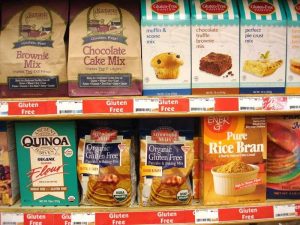I stand in the gluten-free supermarket aisle, scanning my options. Pamela’s chocolate chip cookies replace Chips Ahoy snack-packs, Puffins’ cereal substitutes for Lucky Charms and Nature’s Path waffles stand in for good ol’ Eggo. I don’t have many choices, but I resist a detour down the junk food aisle.

I began eating gluten-free foods after speaking to a nutritionist about the diet’s health benefits. A picky eater by nature, I’m used to eating the same carbohydrate-filled foods every day, which makes this protein-rich diet even more of a challenge.
My typical breakfast meal includes a bowl of oatmeal with brown sugar on top. For lunch, I usually eat a sandwich, chips and a granola bar.
However, for the next two weeks, my new gluten-free diet will consist of nut butter (peanut, almond, cashew) and pancakes for breakfast, a baked potato with feta cheese for lunch and rice pasta for dinner.
Gluten-free diets are increasing in popularity, according to the CBS News “Health Blog.” Many nutritionists believe that gluten-free diets decrease intestinal inflammation and promote overall health.
The gluten-free diet also establishes healthy eating patterns and well-balanced blood sugar, which boosts energy, mood, focus and concentration, and reduces stress levels, according to dietitian Elizabeth Blumberg.
I decided to test the diet for two weeks and evaluate my health at the end of the time span.
Eating meals out was by far the hardest aspect. Even if I ordered a salad, for example, I had to remove the croutons and some dressing.
Although eating gluten-free is definitely harder than I imagined, I don’t regret my decision. The diet gives me a better feeling overall, even though skipping free Georgetown Cupcakes is certainly difficult.
